Mud to Ashes
Background
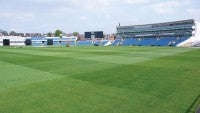 In early 2008, Yorkshire County Cricket Club was awarded a £600,000 grant from the ECB to redevelop the outfield at the Headingley Carnegie Stadium. A requirement of the funding package from the ECB was that the completed outfield was to meet certain drainage performance criteria, the main requirement being a minimum infiltration rate of 30mm per hour. In addition, the funding included the provision of an effective irrigation system and an even playing surface providing safe, secure footing for all players as well as accommodating the needs of the TV and broadcasting companies, in particular the ducting for stump cameras and microphones.
In early 2008, Yorkshire County Cricket Club was awarded a £600,000 grant from the ECB to redevelop the outfield at the Headingley Carnegie Stadium. A requirement of the funding package from the ECB was that the completed outfield was to meet certain drainage performance criteria, the main requirement being a minimum infiltration rate of 30mm per hour. In addition, the funding included the provision of an effective irrigation system and an even playing surface providing safe, secure footing for all players as well as accommodating the needs of the TV and broadcasting companies, in particular the ducting for stump cameras and microphones.
The grant served the dual purpose of enabling the standard of drainage on the outfield to be improved as well as facilitating its partial regrading as part of a major ground redevelopment. At the same time the ECB grant was approved, the club was also involved in the final planning stages for the new Carnegie Pavilion, which was replacing the existing dilapidated Wintershed Stand at the Kirkstall Lane end of the ground. As part of this development, the existing concrete terraced seating area in front of the new pavilion building location was to be extended down onto the northern edge of the outfield in order to accommodate an additional 500 seats.
This not only necessitated losing up to four to five metres of the northern edge of the outfield, but its level here also had to be lowered by as much as 650mm. It was, therefore, paramount that the re-grading of the outfield was completed in advance of any drainage improvement works undertaken. In February 2008, the STRI was engaged by Yorkshire County Cricket Club to undertake the necessary design work for the regrading of the outfield and the associated new drainage scheme. The appointment also involved the preparation of the general contract documentation, including the specification and the bills of quantities, as well as undertaking the tendering process and general contract administration on behalf of the club.
As a preliminary to commencing any design work, a thorough investigation of the existing ground conditions was carried out on the outfield. A series of trial hole investigations indicated that a feature of the existing turf was the presence of a dense matted thatch layer varying from 24-45mm in thickness. The presence of this thatch made the surface somewhat spongy and moisture retentive, as well as helping to slow down the speed of ball roll along the surface.
Beneath the thatch layer, there was a variable cover of clay loam soil, this ranging from 110-225mm in depth. The topsoil had a significant clay content varying between 25% and 33%, beneath which there was a solid and structureless layer of yellow/brown clay subsoil. Pockets of clinker ash were also found at the interface between the topsoil and subsoil layers, but subsequent laboratory analysis confirmed that this was free from excessive levels of PCBs, heavy metals and phenols, and could therefore be safely tipped off site.
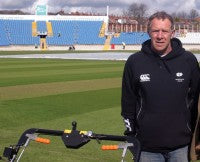
A number of underground services were also found to be present beneath the outfield, some of which would be potentially affected by the proposed works. The most significant of these was a high voltage electricity cable that traversed the northern edge of the outfield, the route of which would be disturbed by the proposed terrace seating extension. Other features included a storm cell attenuation system located immediately in front of the Western Terrace, as well as a series of ducts along the southern outfield serving various CCTV and alarm system cables.
The existing drainage system comprised an incomplete network of original agricultural clay tile drains lying approximately 300-400mm below the surface. These had been supplemented with localised sections of plastic pipe drains installed by the club at various stages over the past thirty years. This included a drainage system installed across to and immediately around the central square.
A topographical survey of the existing outfield confirmed that there was an overall fall across the site of 2.75 metres from the Kirkstall Lane end down towards the rugby ground stand to the south. On the northern half of the outfield the overall slope down to the square was approximately 1 in 43 whilst, on the southern side, the slope eased out slightly to around 1 in 45 to 1 in 50. By comparison, this gradient was much steeper than that across the Lord's ground, which is in the region of 1 in 55.
A noticeable feature of the old outfield was its generally undulating nature with local variations in gradient and directions of fall, which did not make for the best of surfaces for a cricket outfield.
Planning
Once all the background site information had been collated, a start was made on preparing the design and contract documentation. As part of the new pavilion development, the requirement to reduce the extent and level of the outfield meant that the new slope from the Kirkstall Lane end would be reduced to 1 in 80. To the south of the square the existing gradient was largely retained but, to the east, some filling was required to build up a distinct existing low area.
As well as the level adjustment works, the design for the new outfield also included a completely new pipe drainage system supplemented by sand amelioration in the upper topsoil profile, as well as the provision of slit drains. Allowance was also made for the incorporation of fibre reinforcement into the sand ameliorated topsoil layer. A fully automatic irrigation system was also designed for the new outfield, and a grass cover was to be established by laying an imported fibre reinforced turf grown on a sandy rootzone.
The redevelopment of the outfield was also an opportunity to install a network of ducts around the outfield to facilitate the future installation of a floodlighting system for the cricket ground, this being required to accommodate the associated cabling servicing each floodlight pylon.
Tendering and timing
The tendering process took place in March 2008, at the end of which J Pugh-Lewis Ltd of Chesterfield was awarded the contract.
Under normal circumstances the timing of such extensive earth moving and drainage operations would only be considered during the normally drier late spring and summer months, particularly where such a heavy clay profile is involved. However, as cricket is a summer sport, the improvement works were restricted to the most unfavourable late autumn and winter months.
In order to increase the time that the outfield was available, the club agreed to relocate its final home fixtures to their Scarborough ground. Consequently, works were able to commence on the outfield redevelopment on 16th September 2008.
The works 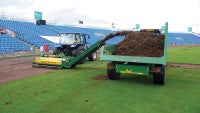
The first requirement was to strip off the existing thatchy turf, which was achieved using two Koro Fieldtopmakers. This work was undertaken on a sub-contract basis by Premier Pitches. A three metre exclusion zone was left around the perimeter of the square (that remained undisturbed) enabling Head Groundsman, Andy Fogarty, and his team to carry out the usual end of season renovation works. The topsoil was then removed.
Before any regrading of the outfield could be undertaken, the existing high voltage cable had to be diverted in order to avoid the new pavilion working area. Once this had been achieved, work could then start on reducing the level at the Kirkstall Lane end of the outfield. This work was carried out using a combination of a 360° tracked excavator and dozer that generated a total of around 2,000m³ of surplus cut material that had to be carted off site to a tip.

Some of this material was used for local filling purposes, mainly to the east of the square, but the bulk of the material, which comprised clay subsoil, was stockpiled at the south-west corner of the outfield before being removed.
On completion of the regrading works, the next requirement was to install a total of 3,000m of ducting for the future floodlighting system. This necessitated installing clusters of 150mm diameter twin walled plastic pipe, with each section comprising between two and five pipes running around the outer edges of the outfield. Once laid, the trenches for these ducts were backfilled to the sub-base level with a "fill" sand.

In addition, a single general purpose duct was laid around the very edge of the outfield, together with replacement ducts for the CCTV/alarm cabling running along the southern boundary. It was only at this stage that a start could then be made on installing the new pipe drainage system.
An early decision was taken to install the drains after grading and prior to returning the topsoil, which goes against normal convention. However, the risk of returning the topsoil on the exposed clay sub-base without any drainage being present was considered too great, owing to the timing of the works during the late winter period.
A network of 80mm lateral drains was therefore installed at 4m intervals over the entire outfield (excluding the central square), and these were connected up to a series of 125mm collecting drains via strategically placed silt chambers. The final outfall for the system was an existing surface water drain located near the East Stand, the flow from which was controlled by a hydrobrake.
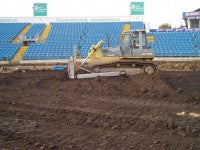
The installation of the drainage system was completed in January 2009, and a start was then made on replacing the topsoil from the 4m high stockpile that had been formed adjoining the southern edge of the square. However, weather conditions at this time started to deteriorate and the remaining earthworks were temporarily suspended.
With the start of the new cricket season looming, it was decided to continue with the installation of the lateral pipe work and sprinklers for the new irrigation system. This comprised a series of Rainbird 8005 infield sprinklers fitted with turf cups spaced at 18m centres. The installation of the irrigation system was sub-contracted to LS Systems Ltd.
The wet weather finally relented and allowed the layer of the stockpiled topsoil to be respread although, again, this was carried out in less than ideal conditions. Indeed, during the installation of the final sections of drainage on the southern and eastern sides of the square, continuous heavy rain showers and deteriorating ground conditions made parts of the outfield look like the Somme battlefield!

In spite of this, and the potential for causing future further soil compaction and destructuring, the works continued in an attempt to minimise any disruption to the overall programme. Just to add to the inclement conditions, a spell of severe frost and snow cover in March led to a further temporary suspension of works.
In early March the project was blessed with a period of almost two weeks of consistently dry and relatively mild weather. This enabled the irrigation works to be substantially completed and a start could then be made on final cultivations and grading of the soil surface, making it ready for the sand amelioration.
The latter was carried out by spreading the sand in two 30mm layers, with the second layer also containing fibre reinforcement. The final finishing off works included power harrowing and raking, this again being undertaken by Premier Pitches. At this stage, the pipe drainage system was supplemented with the introduction of sand and gravel filled slit drains introduced at 750mm centres.

The outfield was eventually made ready for turfing with the first rolls being laid on 27th March 2009, the turf being supplied by Lindum in the form of a 40mm thick big roll grown on a fibre reinforced rootzone material. Laying of the turf was carried out under sub-contract by Talbot Turf and was completed by Good Friday (10th April 2009), just two weeks prior to the start of the new season.
The first season of use
Because of the thickness and stability of the turf, it was agreed that the club could hold three consecutive days of pre-season friendly games on the outfield, the first of these starting just five days after the final turf had been laid. Apart from some minor turf movements under one of the bowlers run ups, the turf held together and play was able to progress unhindered with favourable feedback from the players concerned.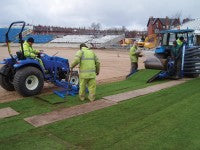
The first scheduled home match of the new season commenced on 26th April 2009 and proceeded without incident, apart from some minor rain delays at the start.
As part of an ongoing monitoring programme of the established outfield, the STRI undertook some initial infiltration tests using double ring infiltrometers. Initial readings taken in early May indicated that sections of the outfield did not comply with the ECB drainage requirements. This was largely due to the presence of a 5-10mm accumulation of thatch at the immediate turf base. Also, there was some inevitable residual compaction within the upper soil profile as a result of the earthworks having been carried out during the adverse winter weather conditions.
At this stage, the turf was not sufficiently well rooted to facilitate compaction relief measures using a vertidrain type machine and, therefore, the only form of aeration possible initially was some relatively shallow solid tine spiking.
The first major test of the outfield came with the advent of the One Day International between England and the West Indies, which was held on 21st May 2009. In the week leading up to this event, there had been repeated rain showers that culminated in a spell of two hours of heavy rain immediately prior to the start of the match. It is well documented that the game was abandoned due to waterlogging of the surface, which was largely due to the retention of the rainwater within the thatch layer contained in the turf.
Beneath the moisture retentive top, the ground was reasonably firm underfoot and there was no evidence of any soft unstable conditions due to any drainage problems lower down in the profile. The abandonment of the match was a major disappointment to the club and consultant alike and, to rub salt into the wound, the remaining two matches of the One Day International schedule were played the following week in perfectly dry and sunny conditions.

A further two weeks passed before the turf was sufficiently well anchored into the underlying soil to enable an initial vertidraining treatment to be undertaken. Through the remainder of June and early July a fairly intensive programme of treatments was implemented with the aim being to further improve surface drainage. This commenced with a hollow tining treatment using a tractor mounted Toro Procore, followed by light scarification with a tractor-mounted scarifier/collector.
Two further vertidraining operations were also carried out to help alleviate some of the underlying compaction. A second set of infiltration tests carried out after this programme of work showed an 85% improvement in terms of the rate of water movement off the surface. The northern and western sections of the outfield exceeded the ECB infiltration rates whilst, to the east and west of the square, the figures fell just below.
During this period, the club also acquired a Jacobsen Tri-King triple mower to assist with routine mowing, and this was also fitted with verticutting units, which are now being used on a monthly basis, again with a view to reducing the thatch content in the turf base.
Sadly, the improved performance of the outfield was not matched by that of the England Test team. Indeed, approximately 25mm of rain fell during the night prior to the first day of the match but the outfield was fit for play by 9.00am.
As part of the end of season renovation works, further vertidraining, in combination with sand topdressing and additional scarifying work, was carried out.
With the completion of the new pavilion, due to be ready later this year, Headingley Carnegie Stadium will provide world-class facilities for both international and county cricket and, with proper ongoing management, it will have an outfield to match.
